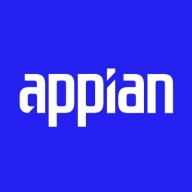

Appian and Apache Airflow compete in the low-code and workflow orchestration markets. Apache Airflow has an edge due to its comprehensive community support and Python-based flexibility, especially beneficial for complex workflows.
Features: Appian offers powerful low-code development capabilities, enabling quick deployment across platforms. It is known for its process modeling and easy integration with existing systems. Appian also provides robust automation and case management. On the other hand, Apache Airflow stands out with its Python-based flexibility, making it ideal for creating detailed workflows. It supports a wide range of plugins, enhancing its functionality for data pipelining. Airflow’s community and open-source model support its rapid adaptability and integration ease.
Room for Improvement: Appian could improve in UI customization and integration flexibility, with SAIL language posing limitations for non-developers. Scalability and mobile app flexibility also need enhancement. Apache Airflow faces challenges with its UI, managing complex workflows, and needs better Windows support. The lack of built-in cyclical workflow support and the need for better documentation are noted issues.
Ease of Deployment and Customer Service: Appian is versatile, supporting public, private, and hybrid cloud deployments, with a competitive edge in customer service despite some limitations in support for complex technical issues. Apache Airflow, mainly used in public cloud and on-premises, benefits from its open-source community for support, but lacks direct vendor engagement.
Pricing and ROI: Appian's pricing is considered high, offering flexible licensing yet proving expensive for smaller enterprises. However, the significant ROI is attributed to its low-code platform and rapid deployment. Apache Airflow’s open-source nature means no licensing costs, making it cost-effective despite additional infrastructure expenses for support, offering an appealing ROI for many organizations.
Using Appian is saving us five full-time employees, which is significant since we currently have only four team members.
They see return on investment in terms of cost savings, time savings, more efficient processes, and more efficient employees.
Appian is very efficient, allowing us to build a lot of applications within a financial year, making it cost-effective.
There is enough documentation available, and the community support is good.
Forums and community resources like Stack Overflow are helpful.
I would give Appian's customer support 10 out of 10 due to their next-level support.
Their customer service is responsive, and the team is very prompt for support.
The technical support for Appian rates as 10 out of 10 because they have a great support team.
The solution is very scalable.
Apache Airflow scales well, especially when deployed in Kubernetes environments.
On a scale of one to 10, Appian rates as a nine for scalability.
Our volume has increased by 20% in the two years since using Appian, and it can handle the increased volume effectively.
Initially, without much coding, I can easily handle five thousand records.
I would rate the stability of the solution as ten out of ten.
Apache Airflow is stable and I have not experienced significant issues.
I would rate its stability at nine out of ten.
We have tested Appian during peak usage and off-peak times, and we have not experienced any issues such as lagging or system disruptions.
It depends on how it has been designed and how it has been configured.
The stability of Appian would rate as nine, as it's a stable environment.
It is not suitable for real-time ETL tasks.
There is no dashboard for us to check all the Directed Acyclic Graphs (DAGs); a dashboard would help us analyze the work better.
If we desire to add custom messengers or a rest API, those options are unavailable.
It has room to improve for use cases where the users are public facing, where anonymous users could come to a site and run a business workflow or interact with some data.
Appian can be improved by adding a geo-location tagging feature, which would be really helpful for identifying remitter addresses.
If there is a very complex process that includes a lot of data transitioning and memory-centric processes, it consumes a lot of memory.
I prefer using the open-source version rather than the enterprise version, which helps manage costs.
It is a sub-feature and not an individual purchase.
Apache Airflow is a community-based platform and is not a licensed product.
Appian provides value for money, is easy to use, has a straightforward setup procedure, and offers great support from the Appian team.
On the pricier side, both Appian and Pega are enterprise-level solutions, placing them on the slightly higher side.
The pricing of Appian is based on the number of users and generally ranges from 70 to 100 USD per user per month.
Apache Airflow is an open-source platform that allows easy integration with AWS, Azure, and Google Cloud Platform.
Reliability is good, and when integrated with Kubernetes, it performs better compared to on-premises environments.
We can create notifications for successful or failed tasks, providing a practical way to monitor our workflows.
The zero-code integration feature is remarkable, allowing for ease of data transfer and workflow enhancement.
Appian is aiding in leveraging AI technologies in multiple ways: one way is for developers, as they make development efficient and quick by enabling developer co-pilots across various phases of the application, which helps design Appian quickly and provides suggestions along the way.
After switching to Appian, it can extract data from MT103, eliminating the need for manual data entry.
| Product | Market Share (%) |
|---|---|
| Apache Airflow | 3.5% |
| Appian | 3.7% |
| Other | 92.8% |


| Company Size | Count |
|---|---|
| Small Business | 13 |
| Midsize Enterprise | 3 |
| Large Enterprise | 24 |
| Company Size | Count |
|---|---|
| Small Business | 20 |
| Midsize Enterprise | 9 |
| Large Enterprise | 42 |
Apache Airflow is an open-source workflow management system (WMS) that is primarily used to programmatically author, orchestrate, schedule, and monitor data pipelines as well as workflows. The solution makes it possible for you to manage your data pipelines by authoring workflows as directed acyclic graphs (DAGs) of tasks. By using Apache Airflow, you can orchestrate data pipelines over object stores and data warehouses, run workflows that are not data-related, and can also create and manage scripted data pipelines as code (Python).
Apache Airflow Features
Apache Airflow has many valuable key features. Some of the most useful ones include:
Apache Airflow Benefits
There are many benefits to implementing Apache Airflow. Some of the biggest advantages the solution offers include:
Reviews from Real Users
Below are some reviews and helpful feedback written by PeerSpot users currently using the Apache Airflow solution.
A Senior Solutions Architect/Software Architect says, “The product integrates well with other pipelines and solutions. The ease of building different processes is very valuable to us. The difference between Kafka and Airflow, is that it's better for dealing with the specific flows that we want to do some transformation. It's very easy to create flows.”
An Assistant Manager at a comms service provider mentions, “The best part of Airflow is its direct support for Python, especially because Python is so important for data science, engineering, and design. This makes the programmatic aspect of our work easy for us, and it means we can automate a lot.”
A Senior Software Engineer at a pharma/biotech company comments that he likes Apache Airflow because it is “Feature rich, open-source, and good for building data pipelines.”
Appian is a unified low-code platform and solution used by businesses to build enterprise applications and workflows. This product adapts to the needs of clients and the technologies they are already using to combine their data in a single workflow and maximize resources. The platform has four main components through which it transforms the work process for companies of various sizes. They are:
Appian is utilized across a diverse set of industries, including automotive and manufacturing, energy and utilities, education, financial services, telecom and media, transportation, retail, insurance, healthcare, and life sciences. The most frequent use cases of Appian are customer journey, governance, risk and compliance, operational efficiency, supply chain, distributed order management, and environmental, social, and governance (ESG) management.
Appian Features
Appian has various features that allow users to create solutions for their businesses. These features can be separated into a few groups according to function, including automation, low-code application development, and integrations and data. Some of the most frequently used features of Appian include:
Appian Benefits
The benefits of using Appian include:
Reviews from Real Users
A practice leader - digital process automation at a computer software company values Appian highly because the product is easy to develop, low-code, and has a good user interface.
Alan G., an advisory board member at Codecon VR, Appian offers a clear application life cycle, easy to learn documentation, and comes with a fundamentals course.
We monitor all Business Process Management (BPM) reviews to prevent fraudulent reviews and keep review quality high. We do not post reviews by company employees or direct competitors. We validate each review for authenticity via cross-reference with LinkedIn, and personal follow-up with the reviewer when necessary.